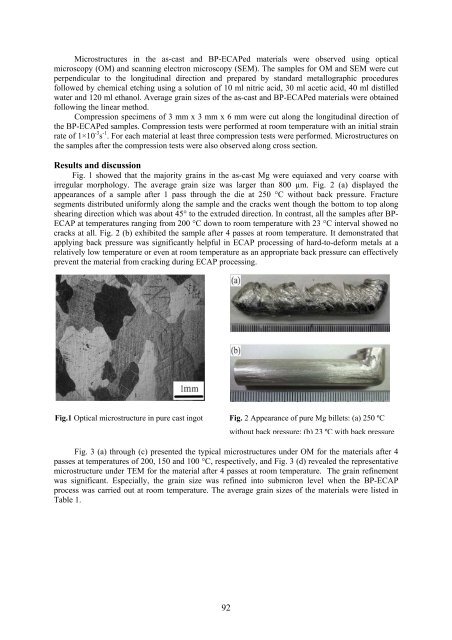Workshop proceeding - final.pdf - Faculty of Information and ...
Workshop proceeding - final.pdf - Faculty of Information and ...
Workshop proceeding - final.pdf - Faculty of Information and ...
You also want an ePaper? Increase the reach of your titles
YUMPU automatically turns print PDFs into web optimized ePapers that Google loves.
Microstructures in the as-cast <strong>and</strong> BP-ECAPed materials were observed using optical<br />
microscopy (OM) <strong>and</strong> scanning electron microscopy (SEM). The samples for OM <strong>and</strong> SEM were cut<br />
perpendicular to the longitudinal direction <strong>and</strong> prepared by st<strong>and</strong>ard metallographic procedures<br />
followed by chemical etching using a solution <strong>of</strong> 10 ml nitric acid, 30 ml acetic acid, 40 ml distilled<br />
water <strong>and</strong> 120 ml ethanol. Average grain sizes <strong>of</strong> the as-cast <strong>and</strong> BP-ECAPed materials were obtained<br />
following the linear method.<br />
Compression specimens <strong>of</strong> 3 mm x 3 mm x 6 mm were cut along the longitudinal direction <strong>of</strong><br />
the BP-ECAPed samples. Compression tests were performed at room temperature with an initial strain<br />
rate <strong>of</strong> 1×10 -3 s -1 . For each material at least three compression tests were performed. Microstructures on<br />
the samples after the compression tests were also observed along cross section.<br />
Results <strong>and</strong> discussion<br />
Fig. 1 showed that the majority grains in the as-cast Mg were equiaxed <strong>and</strong> very coarse with<br />
irregular morphology. The average grain size was larger than 800 µm. Fig. 2 (a) displayed the<br />
appearances <strong>of</strong> a sample after 1 pass through the die at 250 °C without back pressure. Fracture<br />
segments distributed uniformly along the sample <strong>and</strong> the cracks went though the bottom to top along<br />
shearing direction which was about 45° to the extruded direction. In contrast, all the samples after BP-<br />
ECAP at temperatures ranging from 200 °C down to room temperature with 23 °C interval showed no<br />
cracks at all. Fig. 2 (b) exhibited the sample after 4 passes at room temperature. It demonstrated that<br />
applying back pressure was significantly helpful in ECAP processing <strong>of</strong> hard-to-deform metals at a<br />
relatively low temperature or even at room temperature as an appropriate back pressure can effectively<br />
prevent the material from cracking during ECAP processing.<br />
Fig.1 Optical microstructure in pure cast ingot<br />
Fig. 2 Appearance <strong>of</strong> pure Mg billets: (a) 250 ºC<br />
without back pressure; (b) 23 ºC withbackpressure<br />
Fig. 3 (a) through (c) presented the typical microstructures under OM for the materials after 4<br />
passes at temperatures <strong>of</strong> 200, 150 <strong>and</strong> 100 °C, respectively, <strong>and</strong> Fig. 3 (d) revealed the representative<br />
microstructure under TEM for the material after 4 passes at room temperature. The grain refinement<br />
was significant. Especially, the grain size was refined into submicron level when the BP-ECAP<br />
process was carried out at room temperature. The average grain sizes <strong>of</strong> the materials were listed in<br />
Table 1.<br />
92
















